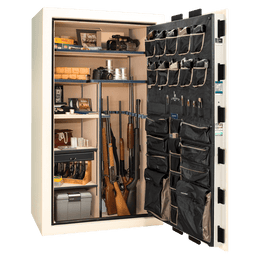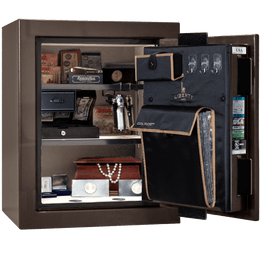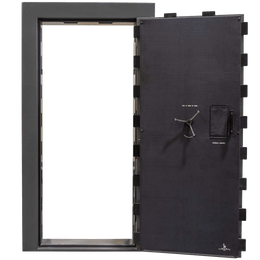Recreational shooting has long been a beloved pastime for many Americans, blending the satisfaction of skill development with the joy of spending time outdoors or at the range. Whether you're plinking with a .22 on a Saturday afternoon or pushing your limits with a precision rifle, recreational shooting offers a fulfilling, safe, and engaging way to unwind and challenge yourself.
Whether you're new to the hobby or an experienced shooter seeking new challenges, this guide will guide you through everything, from essential gear and safety practices to target ideas and purposeful shooting drills.
Where to Shoot: Indoor Ranges, Outdoor Lands, and More
The first question of recreational shooting has got to be “Where?”. We explored this topic in greater detail in our February post, 'Finding the Best Shooting Range.' For your convenience, here's a brief summary:
Where to shoot is going to be either indoor or outdoor, each having its benefits and drawbacks. Outdoor shooting ranges are ideal for those seeking a dynamic, immersive experience. They offer opportunities for long-distance shooting, movement-based drills, and the opportunity to use more interactive targets like steel plates or even just odds and ends from the junk bin. The open space and fresh air enhance the recreational experience. However, they often require travel to remote areas, come with weather-related challenges, and may lack formal safety oversight—especially on public lands. Shooters must also bring their own targets and gear, increasing preparation time.
Indoor ranges, on the other hand, offer convenience, safety, and accessibility, especially for urban or suburban residents. They typically feature controlled environments, automated target systems, and structured shooting lanes. Many facilities also offer classes, competitions, and firearm storage, making them appealing for both casual and serious shooters. Limitations include restrictions on movement, target types, calibers, and rate of fire, which can be confining for the more tactically-minded individual.
Either way, when choosing a range—whether indoor or outdoor—consider factors beyond location and cost. Look for additional offerings such as training programs, community leagues, secure storage, and positive user reviews. To find a range, particularly outdoor locations, explore local parks departments websites, look online for private clubs in your area, call a local gun store for where they know of to shoot, or ask online forums to find quality facilities. If no formal range is nearby, safe and legal shooting on public or private land is an alternative, just be sure to secure permission and research and follow local regulations.
Hopefully, this gets you started in the right place and maybe opens your mind toward looking around for a new place to shoot that better suits your needs and goals.
Know Before You Go: Laws, Safety, and Firearm Familiarity
Before you load up your car and head out, take time to review local laws and regulations, particularly if you are shooting outdoors. Are you shooting on public or private land? What’s the required distance from roads, homes, or trails? Some public lands are designated shooting areas, but others may have restrictions. A quick call to your local sheriff's office, fire department, or BLM ranger can save you from hefty fines or worse.
Once you’ve found a place to shoot and understood the rules surrounding shooting there, the next step is to familiarize yourself with your equipment. You don’t need to be a gunsmith or have any specialized knowledge, but understanding how to clear a malfunction, field-strip your firearm, and safely load and unload is essential. Mishandling a firearm due to unfamiliarity is a leading causes of preventable accidents, and the importance obtaining familiarity in a controlled environment before firing begins cannot be understated.
Equally important is a solid grasp of the four fundamental rules of firearm safety (stated here for convenience):
- Treat every gun as if it’s loaded.
- Never point the muzzle at anything you’re not willing to destroy.
- Keep your finger off the trigger until you’re ready to fire.
- Be sure of your target and what’s beyond it.
Following these principles consistently will drastically reduce the risk of injury.
Another helpful tip that is not as common as it should be is keeping a basic first-aid kit handy. From minor cuts to more serious incidents, being prepared can make all the difference—especially when you're far from medical help.
Starting with the Basics: Essential Shooting Gear
Before heading to the range or out into the field, it’s important to ensure you have the proper gear to enjoy your time safely and efficiently. At the core of that list: eye and ear protection. Eye protection is non-negotiable. Even a cheap pair of clear or tinted safety glasses can prevent serious injury. Ricochets, ejected casings, and mechanical malfunctions all pose risks to your vision. You may feel silly wearing them at first, but you'll be far more thankful if something goes wrong. Ear protection is equally critical. Many shooters opt to double up, using foam earplugs inside of over-the-ear muffs. Surprisingly, foam plugs often offer a higher noise reduction rating than earmuffs alone. Combining the two greatly reduces the risk of long-term hearing damage. These protective measures can be purchased and added to your kit for $25 or less, and are a no-brainer no matter your skill level.
Gear Organization and Shooting Setup
You'll also want to think about how you'll organize your gear at the range, especially if you're shooting outdoors. A portable table or even a blanket can help keep firearms, ammunition, and accessories clean and off the ground. A quality range bag helps keep essentials together and minimizes the chances of forgetting something. Another underappreciated tool are garbage bags. Whether you're cleaning up spent brass, used targets, or leftover cans, being a responsible shooter includes tidying up after yourself—and sometimes even after others. “Leave no trace” isn’t just for hikers; it’s what keeps public land accessible and enjoyable for everyone.
Target Options
There’s no need to spend a fortune on targets to have a good time. Plenty of free printable paper targets are available online—just tape them to cardboard boxes or old backboards, and you're good to go. Simple target stands eliminate the need to pack in your own boxes, and are very affordable options as well. Once you've got your sights dialed in, reactive targets are where the real fun begins. Aluminum cans, plastic jugs, and water bottles make for great reactive targets. Fill them with water for dramatic feedback on impact. You can easily collect a week’s worth from your garbage bin and enjoy a cost-free shooting session. Rubber targets or various non-inflated balls, like golf balls and tennis balls, are another cheap and simple target that can still provide use after hundreds of hits and require no effort to set up.
For those looking to invest in longer-term fun, steel targets are well worth the money. Ranging from simple silhouettes to dueling trees, they offer instant, audible feedback with every hit, making them a favorite for both casual and competitive shooters. Just make sure to follow proper safety guidelines and use the correct caliber for your steel at the correct distances.
What to Shoot
If you're just starting out and looking to enjoy some casual trigger time on the weekends, walking into the world of firearms can feel overwhelming—there’s no shortage of strong opinions or endless choices when it comes to selecting your first gun. A smart place to begin? The classic .22 Long Rifle. Firearms chambered in .22 LR are inexpensive to buy and shoot, produce minimal recoil, and are ideal for developing the fundamentals of marksmanship. They allow you to get hands-on experience, learn proper handling and shooting techniques, and explore your interests—whether that’s long-range accuracy, defensive skills, or simply plinking—without breaking the bank on ammo.
Starting with a .22 also gives you time to figure out what really matters to you: where you want to improve, what types of shooting you enjoy most, and which upgrades are worth investing in later. We would be remiss not to say that The Vault has several in-depth articles reviewing top .22 options and other firearms when it comes time to choosing a new addition to the safe. Whether you choose a rifle or a handgun, let your personal interests guide you. A .22 rifle is excellent for those drawn to precision and distance; a .22 pistol, on the other hand, is perfect if you’re leaning toward self-defense practice. And don’t let anyone talk down the humble .22. It may seem modest, but many of the world’s finest marksmen began their journey with a rimfire. The .22 LR isn’t just a beginner’s tool—it’s a time-tested platform that builds the foundational skills every great shooter relies on. It’s no wonder that a well-loved .22 plinker remains a constant companion at the range, even in the collections of lifelong enthusiasts.
Shooting with Purpose: How to Get More Out of Your Range Days
While casual plinking is always fun, adding some structure can significantly improve your skills and enjoyment. In terms of structure to the shooting itself, a few approaches to consider adding to your schedule could be:
- Accuracy challenges: Shoot for tight groups at various distances, stretching yourself the further out you go.
- Speed drills: Time yourself hitting multiple targets in succession.
- Position shooting: Practice from standing, kneeling, prone, and seated positions.
- Skeet or trap shooting: Add a moving target challenge to build hand-eye coordination.
The key is to explore and experiment. Recreational shooting is a highly personal and dynamic pursuit—what excites one person may not appeal to another. Trying out different shooting disciplines and drills not only helps you discover what you genuinely enjoy but also keeps the experience fresh and engaging over time. As you explore, dtake your time and on’t rush the process. Avoid the trap of comparing yourself to more experienced shooters or trying to skip past the fundamentals in pursuit of speed or flash. Mastery takes time. The old saying “slow and steady wins the race” holds true in shooting as well. When learning a new skill, focus on taking deliberate, well-aimed shots. Pay close attention to your form, your breathing, and your results—each round is a chance to identify areas for growth and to reinforce good habits that will serve you for years to come.
One of the best ways to make the most of these drills and improve your shooting over time is to keep a shooting journal. It doesn’t have to be fancy—just a notebook or digital doc where you jot down things like the zero distance and corresponding load used for each firearm in your arsenal, what accuracy you achieved with each firearm when zeroing, any malfunctions or firearm performance observations, performance on what drills you did that day, or what was fun and what you want to do more of next time you head to the range.
Over time, this record becomes invaluable. Instead of trying to remember your rifle’s zero or preferred bullet type, you can reference your notes and pick up where you left off. You can have a pre-made plan for each range session while it was fresh on your mind the last time, and by so doing turn your casual range sessions into opportunities for intentional skill development.
Final Thoughts: A Hobby That’s as Fun as It Is Fulfilling
Recreational shooting offers something for everyone—from meditative long-range sessions to action-packed target transitions. With the right mindset, basic gear, and an openness to learn, you can quickly grow from casual plinker to confident marksman.
Above all, however, the important thing is to enjoy yourself. This is a hobby rooted in freedom, personal responsibility, and fun. Whether you’re shooting solo, with friends, or introducing someone new to firearms, keep safety at the forefront, respect the land and facilities you use, and never stop learning. You just might find recreational shooting to be one of the most rewarding hobbies you’ll ever take up.
*Made in the U.S.A. from U.S. and Global Parts.







